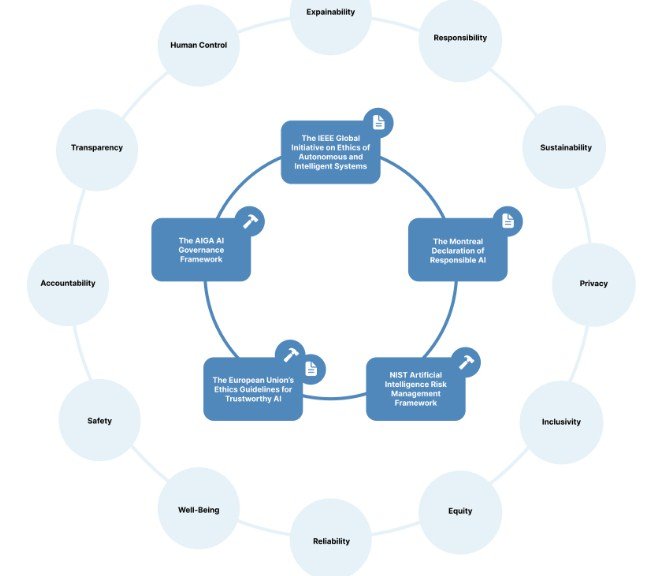AI governance is more than just a buzzword. It is a crucial aspect of ensuring that AI systems are developed, deployed and used in ways that are ethical, legal and beneficial for the organization and its stakeholders. AI governance is not a one-size-fits-all solution, but rather a tailored approach that reflects the specific needs, goals and risks of each AI project and use case. In this article, we will explore some of the key steps and best practices for creating and implementing an effective AI governance program for your organization.
Understand the need and purpose of AI governance
Before launching an AI governance program, it is important to understand why you need it and what you want to achieve with it. AI governance is a system or framework designed to direct, manage and monitor the AI activities of an organization. If your company is designing, developing or deploying AI systems, you should consider building out an AI governance program and tailor it according to how your company interacts with AI systems.
Some of the benefits of AI governance include:
- Enhancing the trustworthiness, reliability and safety of AI systems
- Reducing the legal, ethical and reputational risks associated with AI use
- Aligning the AI strategy with the organizational vision, values and objectives
- Fostering a culture of accountability, transparency and responsibility for AI
- Increasing the competitive advantage and innovation potential of AI
Some of the challenges of AI governance include:
- Keeping up with the fast-paced and dynamic nature of AI development and use
- Balancing the trade-offs between innovation, regulation and ethics
- Addressing the complexity and diversity of AI systems and use cases
- Engaging and collaborating with multiple stakeholders and experts
- Measuring and evaluating the impact and performance of AI
Define the scope and focus of your AI governance program
Once you have established the need and purpose of your AI governance program, you need to define the scope and focus of it. This means identifying the AI systems and use cases that fall under the purview of your AI governance program, and prioritizing the most critical and relevant ones. You also need to determine the level and type of governance that is appropriate for each AI system and use case, depending on the potential benefits and risks involved.
Some of the factors to consider when defining the scope and focus of your AI governance program include:
- The nature and purpose of the AI system and use case
- The data sources and quality of the AI system and use case
- The stakeholders and users of the AI system and use case
- The legal and regulatory requirements and standards applicable to the AI system and use case
- The ethical and social implications and expectations of the AI system and use case
Map and assess your AI systems and use cases
After defining the scope and focus of your AI governance program, you need to map and assess your AI systems and use cases. This means documenting and analyzing the technical, operational and organizational aspects of your AI systems and use cases, and identifying the potential opportunities and challenges they pose. You also need to evaluate the impact and performance of your AI systems and use cases, and monitor them for any changes or issues.
Some of the steps and tools to help you map and assess your AI systems and use cases include:
- Creating an AI inventory that lists and categorizes all the AI systems and use cases in your organization
- Conducting an AI risk assessment that identifies and quantifies the potential harms and benefits of your AI systems and use cases
- Developing an AI impact assessment that evaluates the social, environmental and economic effects of your AI systems and use cases
- Implementing an AI audit that verifies the compliance, accuracy and fairness of your AI systems and use cases
- Establishing an AI feedback mechanism that collects and responds to the inputs and outputs of your AI systems and use cases
Develop and apply your AI governance framework
The final step of creating and implementing an AI governance program is to develop and apply your AI governance framework. This means setting and enforcing the rules, policies and procedures that guide and regulate the AI activities of your organization. You also need to communicate and educate your stakeholders and users about your AI governance framework, and review and update it regularly.
Some of the components and resources to help you develop and apply your AI governance framework include:
- Defining an AI vision and strategy that articulates the goals and values of your organization for AI
- Adopting an AI code of ethics that outlines the principles and norms of your organization for AI
- Establishing an AI governance team or committee that oversees and coordinates the AI governance program
- Designing an AI governance process that defines the roles and responsibilities of your organization for AI
- Leveraging an AI governance platform or tool that supports and automates the AI governance program
AI governance is not a one-off task, but an ongoing commitment that needs a dynamic and adaptive approach. By initially defining the need and purpose of your AI governance program, conducting a comprehensive mapping and assessment of your AI systems and use cases, and developing and applying a customized AI governance framework, you can both mitigate the associated risks and cultivate the innovation potential of AI in your organization.

